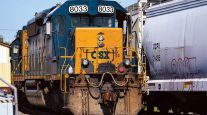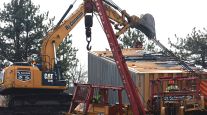Pinched by Fewer Energy Products, Rail Carriers Broadening Customers

This year will be another disappointing one for freight rail carriers hauling fewer carloads of coal and natural-gas drilling supplies through southwestern Pennsylvania.
Through three-quarters of the financial year, coal’s decline and a pullback in oil and gas drilling continued to pinch carriers like CSX Corp., Norfolk Southern Corp. and Genesee & Wyoming Inc., all of which have rail lines through Pittsburgh and have historically leaned on shipments of energy products through the region.
RELATED: CSX’s net income falls 10%
If there is a light at the end of the tunnel for energy products, it’s that analysts expect coal could begin to rebound in 2017.
But railroads can’t afford to wait. Rail carriers have been broadening their customer base by shedding facilities and rail lines related to coal and building others to attract revenue from more diverse shippers.
RELATED: Earnings turmoil deepens at railroads as trucks poach freight
This national transition is on display in Pittsburgh, as Jacksonville, Fla.-based CSX, the third-largest rail carrier in the country, works to complete a $60 million shipping facility in the Pittsburg area by next summer.
This fall, construction crews have been digging underground utilities that will serve the facility, which is on a 70-acre site of the former Pittsburgh and Lake Erie railroad yard. Once that is completed, construction on an administration building will begin, according to a project update posted on CSX’s website.
Once completed, the terminal will allow products to be shipped by rail to the facility in McKees Rocks, Pennsylvania, then transferred to trucks for transport to their final destination.
The facility is “perfectly positioned to support the flow of goods from East Coast ports into the consumption centers of the Ohio Valley and Midwest,” Melanie Cost, spokeswoman for CSX, wrote in an e-mail.
CSX has said it is trying to lure customers to consider including rail in their shipping strategies. It is also hoping to take advantage of an expected increase in shipments arriving from East Coast ports, thanks to an expanded Panama Canal, a decade-long project completed this past summer.
“If you take out the coal business ... and we look at the rest of the portfolio, our merchandise and intermodal business, we feel pretty good based on the economic indicators we’re seeing right now,” said Fredrik Eliasson, CSX’s chief sales and marketing officer, during an earnings call in October.
Rail executives painted a universally dim picture for coal, once a prized commodity on the railroads.
Coal revenue at Norfolk Southern, which is based in Virginia, dropped 18% from the same quarter a year ago. Shipments of coal dropped by 12% at Genesee & Wyoming, a Connecticut-based short line operator with four lines in Pennsylvania that once saw a boost from moving both coal and frack sand for natural-gas drilling.
Norfolk Southern has responded with cost-cutting initiatives, such as closing difficult-to-operate lines in the coal fields and rerouting trains onto the main line — and even slowing down trains on existing lines to reduce the need for maintenance.
Analysts have praised CSX’s ability to diversify its operations. In the third quarter, about 17% of CSX’s total revenue came from coal shipments. That’s down from 32% of revenue for the full year 2011.
Brian Ossenbeck, a freight transportation analyst for J.P. Morgan, wrote last month that CSX “is positioned to grow in its largest end market of intermodal, where a combination of new hub construction and road-to-rail conversion bode well for longer-term volumes.”
The terminal could also help attract more business locally. Next to the facility, commercial real estate broker CBRE Group Inc. is marketing about 700,000 square feet of building space, spread across multiple buildings, which could be used for warehousing, distribution and offices.
R.T. Walker, a vice president at the company’s Pittsburgh office, said, “We’ve had quite a bit of early interest” in the property, driven in part by future traffic related to Royal Dutch Shell’s planned ethane cracker plant in Beaver County. “We have had numerous tours and meetings with possible users related to the cracker plant,” Walker said.
Though the terminal will have a wide range of customers, CSX and other regional railroads hope to harness the movement of supplies and products when the cracker plant is being built and when it is operational.
“We hope that the economics of freight rail make it the preferred transportation mode for many of the petrochemical customers likely to set up shop in the Pittsburgh region,” said Ryan Fischer, assistant vice president of industrial development for Genesee & Wyoming, which will service the adjacent CBRE property.
“In turn, a growing cluster of companies centered around the Shell cracker could be a real shot in the arm for the local railroads,” he added.
Next year, the carriers plan to pare steep coal losses. CSX expects coal going to power plants to increase by about 2 percent in the fourth quarter, compared with the year-ago quarter.
Ossenback’s report notes that, in 2017, coal production is expected to be up about 10% in areas that CSX services.
“Coal remains a question, but not a four-letter word,” he wrote.
Distributed by Tribune Content Agency, LLC




